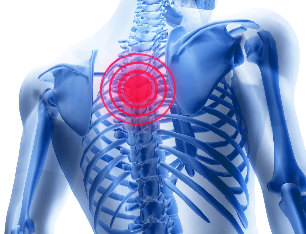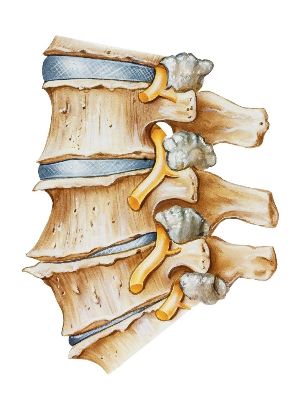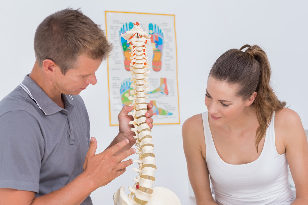The chest of the osteocondrose is a chronic disease and is based on degenerative diseases-degenerative diseases defeat of the intervertebral discs of cartilage, which, resulting in a beam shift on the part of the bodies of the vertebrae and its soft tissue. The disease is more common and mainly affects people of working age (25 to 45 years of age).
The chest of the osteocondrose quite as rare as they were, and that for the lumbar spine or the cervical spine. This is due to the fact that this department is the spinal column occur in a less static and motor load on the others. However, the osteocondrose the thoracic spine is much more difficult to diagnose, because it it is, in the majority of cases, are owing, as a disease of the lung, the heart, of the organs in the upper layer of the digestive tract.

Causes and risk factors
Currently, the exact causes for the development of breast-feeding, disease of degenerative disc disease of the hard disk is not installed. The experts requested that a set of theories (infectious, in the event of an allergic reaction, genetic, mechanical, hormonal, and vascular), but none of them give a full and clear explanation of the pathological changes that occur in the spine, leading to degeneration of tissues. Most likely, the pathological mechanism of the development of breast degenerative disease of the disk, it is simultaneously part of a number of factors. But the most important thing of value that belongs to a long-static-dynamic-overload of the spine segment.
The factors that are the cause of such an overload are the following:
- abnormalities in the structure of the spinal column;
- the asymmetric location of the joint gaps at the joints of the spinal;
- inherent in the narrowing of the spinal canal;
- spondylogenic of muscular (soft-tissue, reflected, and/or the body (which are reflected, they take place in the context of a number of diseases of the blood vessels, and internal organs) of the pain.
- long-term exposure to the vertebral column of a vibration, for example, the drivers of the vehicles;
- and over-voltage;
- with the obesity.
- it is prohibited to;
- a sedentary lifestyle (lack of exercise);
- the psychosocial factors.
The mobility of the spinal column, it is ensured by means of the intervertebral disc, which is also in play, and the absorption of the paper. In its centre is located on the elastic you don't suffer from the kernel, the part which is in a large quantity, it enters the water. When osteocondrose the nucleus begins to lose water as a result of the demineralization of the polysaccharides. Over time, the nucleus flattens and it flattens and the intervertebral disc. Under the influence of the load on the mechanical ring of the fibrous protrusions, a process called protrusion. Later in the drive, the explosion, which occur in the fragments from the gel to the kernel, that is, there is the formation of a hernia of the intervertebral disc.

The reduction of the height of the disc leads to the alignment of the vertebrae adjacent to each other, in violation of the anatomy of the facet joints. All of it launches itself from the inflammation in the facet joints, and surrounding, tissues. In addition, the convergence of the bodies of the vertebrae, accompanied by a stretching of the joint capsule and is struck in the segment of the spinal column becomes unstable. The body of the vertebra to receive the excess of their mobility, which may be the cause of the violation of the spinal column is the root, and the root development of the disorder.
At the bottom of the breast-feeding, degenerative disc disease is to gradually expand the tissue to the bone in the vertebral column and the bony growths (bone spurs). They can also cause the syndrome, radicular or myelopathy compression (compression of the spinal cord).
Rating
On the basis of the classification of breast-feeding, degenerative disc disease, is posindromnoy the beginning. Depending on which neural and education to their deaths in the structures of the spine are to make an impact, including the following conditions:
- compression on the basis of its development, that is, the tension, the deformation or compression of the division from the ground up, on the stage, the spinal-cord or the blood vessel, depending on the developing spine, and other vascular diseases, or radicular pain syndromes;
- reflex – is associated with the reflected voltage is innervated by the muscular and degenerative diseases, and other diseases with vascular disabilities.
- bioadaptive.
The symptoms of breast-feeding, degenerative disc disease.
The main symptom of breast-feeding, degenerative disc disease, is pain. In the majority of cases, it takes an idiot is mild.
The long-irritation of the root of the spinal nerve becomes the root cause of the breaches of the nerve supply of the internal organs. Depending on the level of the lesion, the breast of the osteocondrose you can escape to, under the mask of disease somatic:
| The level of the lesion | Innervated by a of the organs | The clinical symptoms |
| The C7-Th1 | On the hand, the wrist, the palm of the hand, and trachea (windpipe), esophagus, | Aches and pains in the hands and on the palms of the hands, and bronchial asthma |
| Cells Of Th2 Th3 | The heart, pericardium, coronary arteries | Coronary artery disease, arrhythmias, |
| Th4-Heated, Heated-Th5 | The bronchi, lungs, pleura, the mammary glands, nipples, | Bronchitis, pneumonia, pleural effusion>[!@#$], bronchial asthma |
| - Warm Heater Th5-Th6 | The common bile duct, the gallbladder | Gallstone disease is a violation of the process of the assimilation of the fat |
| Th6-Th7 | In the liver, the solar plexus | Impairment of the function of the liver |
| Th7-Th8 | The stomach | Dyspepsia, gastritis, peptic ulcer disease, gastric and duodenal |
| Th8-Th9 | In the duodenum, and the pancreas | Eating disorders, and chair, duodenitis, pancreatitis |
| Th9-Th10 | In the spleen, diaphragm | She starts breathing a violation |
| Th10-Th11 | The adrenal glands | Allergic reactions, a decrease in it can increase the immunity of |
| Th11-Th12 | The kidney | Pyelonephritis, urolitíase |
| Th12-L1 | In the kidney, and the ureters | Disorders of micturition |
In this regard, the most commonly presented symptoms in the breastfeeding and degenerative disc disease are:
- the pain in the breast (behind the sternum, at the side, with his back to the intercostal or middle) – they can be razor-sharp, and the pain obtuse; at times, radiating into the hand.
- the pain in the region of the epigastrium – to occur, regardless of the nature of the feed, the characteristics of the diet, often combined with acid reflux, a painful, causing, abdominal pain, nausea, vomiting;
- pain in area of right hypochondrium – has been amplified by the change in the position of the patient's body, sneezing, coughing;
- the pain in the lower back – simulate an attack of renal colic, is often mixed with dysuric disorders.

When the compression of the nerve root of the patient's breast osteochondrosis and develops a heart attack, on the intercostal neuralgia. To him, it is characterized by the occurrence of reported severe pain in one half of the chest (torakalgiya). Pain take body's nature, and spread by the movement of one of the intercostal nerves from the spine to the sternum. The patient describes it as, "the impact of an electric shock," or "appearances". The pain can give in the area of the epigastrium, retrosternal area, and with the knife, the hand, and combined with some of the other symptoms (the location of the hyperhidrosis, pallor or flushing of the skin, associated with the defeat of the sympathetic fibers of intercostal nerves.
For neuralgia intercostal arteries is characteristic of a pain in paroxysms, lasting from a few seconds to several minutes. During a crisis, the pain will become unbearable. Trying in some way to ease the condition of the patient to decrease at a certain position of the body, and avoiding deep breaths, coughing, sneezing, and round and round.
Off-the starting point of the pain of a heart attack in the patients that are marked paresthesia (subjective to the violation of the sensitivity of the skin in the form of a trace, cold flashes with goose bumps, tickling, pins and needles) needles), over the course of the intercostal space.
The diagnosis
The diagnosis of breast disease, degenerative disc disease of the disc is performed based on the data in an objective review the patient's laboratory and research tool that includes the following:
- the general examination of the blood-moderate leukocytosis, increased ESR);
- the electrolytes in the serum of the blood (decreased calcium);
- the general analysis of urine;
- biochemical analysis of the blood.
- x-ray study of the thoracic spine (detected in the flattening of the intervertebral disc, the deformation of the contacts in the plates of the bodies of the vertebrae adjacent to each other, the changing of the bodies of the vertebrae adjacent to each other;
- scintigraphy of the spine (it identifies the active process of mineralization of bone of the vertebral bodies);
- myelography;
- scans, and magnetic resonance imaging, a brain scan.
The chest of the osteocondrose requires a differential diagnosis with the following diseases and disease states:
- dishormonal spondylopathy;
- spondylolisthesis;
- the inflammatory responses;
- ankylosing spondylitis;
- osteomyelitis of the vertebral column;
- in the rheumatoid arthritis (ra);
- neoplastic processes (metastatic or primary tumors of the chest);
- fractures of the spinal column;
- of gastrointestinal disease (chronic pancreatitis, peptic ulcer disease, gastric and duodenal, diverticulitis, irritable bowel syndrome);
- diseases of the urogenital system (urolitíase, pyelonephritis);
- heart disease (coronary artery disease, irregular heartbeat).

For the treatment of breast degenerative disc disease.
For the treatment of breast degenerative disc disease is performed on an outpatient basis. When expressed pain syndrome in the patient with in 2 to 3 days prescribe rest. It shows the all-wheel drive is a victim of a segment of the spinal column, avoiding compression of the nerve root and, therefore, to stop the pain that is caused. When expressed pain syndrome and go into the soft tissue, a 2% solution of novocaine. In short, the progress can be attributed to the anti-inflammatory drugs do not.
The scheme of treatment of complex maternal and degenerative disc disease are also included.
- the antihistamines;
- the b complex vitamins;
- tranquilizers;
- acupuncture;
- the type of massage;
- the chiropractic treatment.
Improving the health status of the patient is taken to the classroom to deal with physical exercises. The regular practice of physical exercise in breast cancer and osteocondrose contribute to the formation of a well-developed muscular corset, which allows you to keep the spine in correct position, the physiological, eliminates excess static charge.
Of great importance in the treatment of breast-feeding, degenerative disc disease, intended to regular, moderate exercise (such as swimming, yoga, tai-chi), with the normalization of body weight. Jumping, running, weight lifting, and other sports, together with high loads on the vertebral column, they are counter-indicated.
The surgical treatment of breast-feeding, degenerative disc disease is shown only in the case of a significant compression of the spinal cord. In such a case, depending on which of the statement is running:
- the stabilization of the spine in the segment.
- the substitution of a victim of the artificial disc implant;
- surgery and reconstruction of the site;
- puncture spray the victim of a hard drive;
- microdiscectomy.
The consequences and complications of
Long the irritation or compression of a nerve root can result in the development of the somatic illnesses of the organs in the thorax, the upper layer of the digestive tract, from the kidneys. The greatest danger is to the rib cage, osteocondrose is on the attack.
Also, the effect of breast-feeding, degenerative disc disease can make the disease of the esophagus, stomach, duodenum, pancreas, gall bladder, lungs, and the formation of intervertebral hernia is.
Forecast
The chest of the osteocondrose it featured the wavy stream, the rates of remission, they are monitored for medical conditions. When, in time, developed a treatment while observing the patient all the recommendations of your doctor about how the therapy of the disease and the lifestyle changes, the prognosis is favourable.
Prevention
For the prevention of breast-feeding, degenerative disc disease include:
- the normalization of body weight;
- stop smoking;
- an active life-style.
































